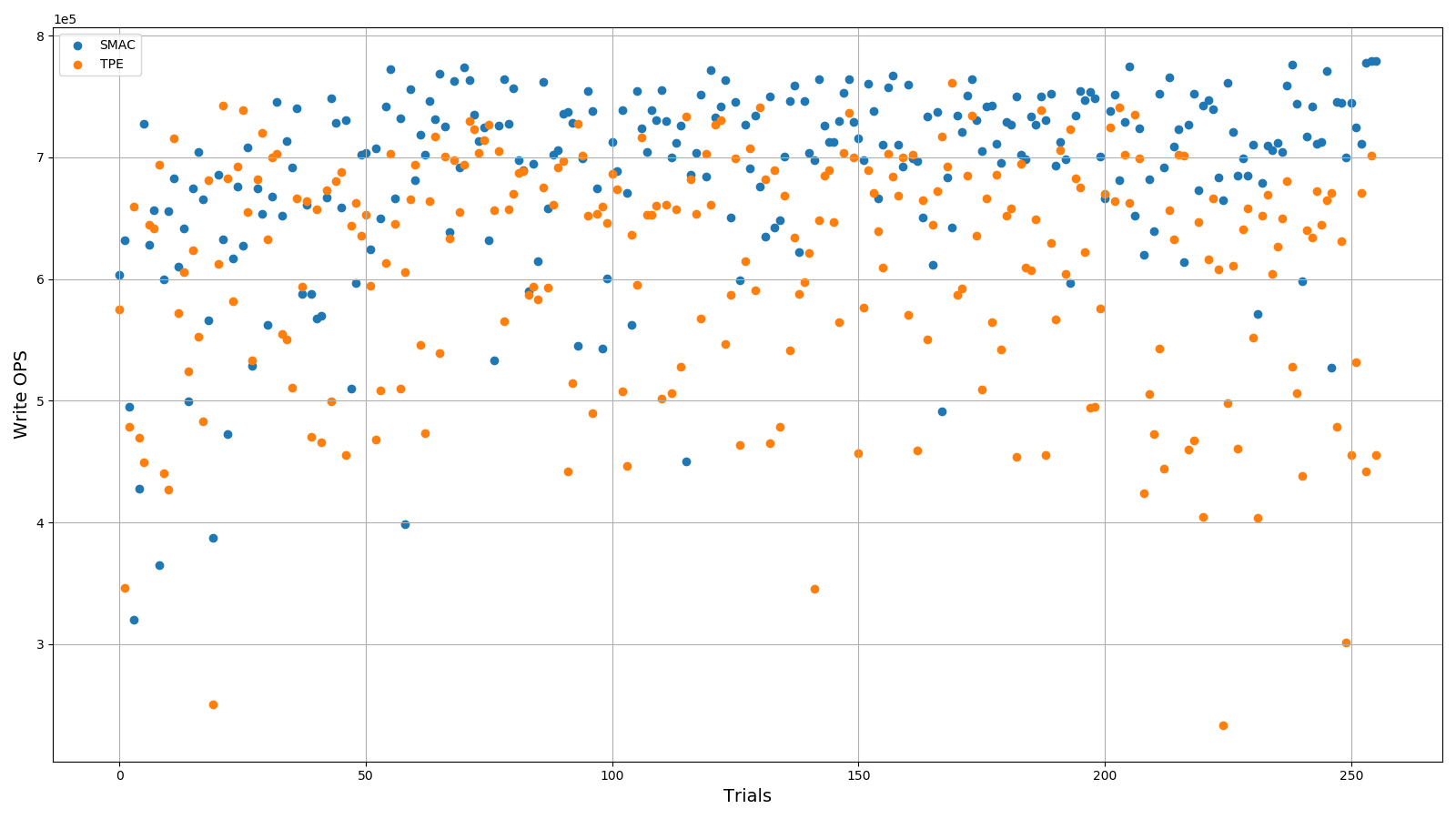Tuning RocksDB on NNI¶
Overview¶
RocksDB is a popular high performance embedded key-value database used in production systems at various web-scale enterprises including Facebook, Yahoo!, and LinkedIn.. It is a fork of LevelDB by Facebook optimized to exploit many central processing unit (CPU) cores, and make efficient use of fast storage, such as solid-state drives (SSD), for input/output (I/O) bound workloads.
The performance of RocksDB is highly contingent on its tuning. However, because of the complexity of its underlying technology and a large number of configurable parameters, a good configuration is sometimes hard to obtain. NNI can help to address this issue. NNI supports many kinds of tuning algorithms to search the best configuration of RocksDB, and support many kinds of environments like local machine, remote servers and cloud.
This example illustrates how to use NNI to search the best configuration of RocksDB for a fillrandom benchmark supported by a benchmark tool db_bench, which is an official benchmark tool provided by RocksDB itself. Therefore, before running this example, please make sure NNI is installed and db_bench is in your PATH. Please refer to here for detailed information about installation and preparing of NNI environment, and here for compiling RocksDB as well as db_bench.
We also provide a simple script db_bench_installation.sh helping to compile and install db_bench as well as its dependencies on Ubuntu. Installing RocksDB on other systems can follow the same procedure.
Experiment setup¶
There are mainly three steps to setup an experiment of tuning systems on NNI. Define search space with a json file, write a benchmark code, and start NNI experiment by passing a config file to NNI manager.
Search Space¶
For simplicity, this example tunes three parameters, write_buffer_size, min_write_buffer_num and level0_file_num_compaction_trigger, for writing 16M keys with 20 Bytes of key size and 100 Bytes of value size randomly, based on writing operations per second (OPS). write_buffer_size sets the size of a single memtable. Once memtable exceeds this size, it is marked immutable and a new one is created. min_write_buffer_num is the minimum number of memtables to be merged before flushing to storage. Once the number of files in level 0 reaches level0_file_num_compaction_trigger, level 0 to level 1 compaction is triggered.
In this example, the search space is specified by a search_space.json file as shown below. Detailed explanation of search space could be found here.
{
"write_buffer_size": {
"_type": "quniform",
"_value": [2097152, 16777216, 1048576]
},
"min_write_buffer_number_to_merge": {
"_type": "quniform",
"_value": [2, 16, 1]
},
"level0_file_num_compaction_trigger": {
"_type": "quniform",
"_value": [2, 16, 1]
}
}
Benchmark code¶
Benchmark code should receive a configuration from NNI manager, and report the corresponding benchmark result back. Following NNI APIs are designed for this purpose. In this example, writing operations per second (OPS) is used as a performance metric.
Use
nni.get_next_parameter()to get next system configuration.Use
nni.report_final_result(metric)to report the benchmark result.
Config file¶
One could start a NNI experiment with a config file. A config file for NNI is a yaml file usually including experiment settings (trialConcurrency, trialGpuNumber, etc.), platform settings (trainingService), path settings (searchSpaceFile, trialCodeDirectory, etc.) and tuner settings (tuner, tuner optimize_mode, etc.). Please refer to Experiment Config Reference.
Here is an example of tuning RocksDB with SMAC algorithm:
Here is an example of tuning RocksDB with TPE algorithm:
Other tuners can be easily adopted in the same way. Please refer to here for more information.
Finally, we could enter the example folder and start the experiment using following commands:
# tuning RocksDB with SMAC tuner
nnictl create --config ./config_smac.yml
# tuning RocksDB with TPE tuner
nnictl create --config ./config_tpe.yml
Experiment results¶
We ran these two examples on the same machine with following details:
16 * Intel(R) Xeon(R) CPU E5-2650 v2 @ 2.60GHz
465 GB of rotational hard drive with ext4 file system
128 GB of RAM
Kernel version: 4.15.0-58-generic
NNI version: v1.0-37-g1bd24577
RocksDB version: 6.4
RocksDB DEBUG_LEVEL: 0
The detailed experiment results are shown in the below figure. Horizontal axis is sequential order of trials. Vertical axis is the metric, write OPS in this example. Blue dots represent trials for tuning RocksDB with SMAC tuner, and orange dots stand for trials for tuning RocksDB with TPE tuner.

Following table lists the best trials and corresponding parameters and metric obtained by the two tuners. Unsurprisingly, both of them found the same optimal configuration for fillrandom benchmark.
Tuner |
Best trial |
Best OPS |
write_buffer_size |
min_write_buffer_number_to_merge |
level0_file_num_compaction_trigger |
|---|---|---|---|---|---|
SMAC |
255 |
779289 |
2097152 |
7.0 |
7.0 |
TPE |
169 |
761456 |
2097152 |
7.0 |
7.0 |